| June 6, 2018
Three Into Two
Do three wheels and three cylinders equate to three times the fun versus a motorcycle? We go for a 183-mile ride through the curvaceous Austrian Alps to find out.
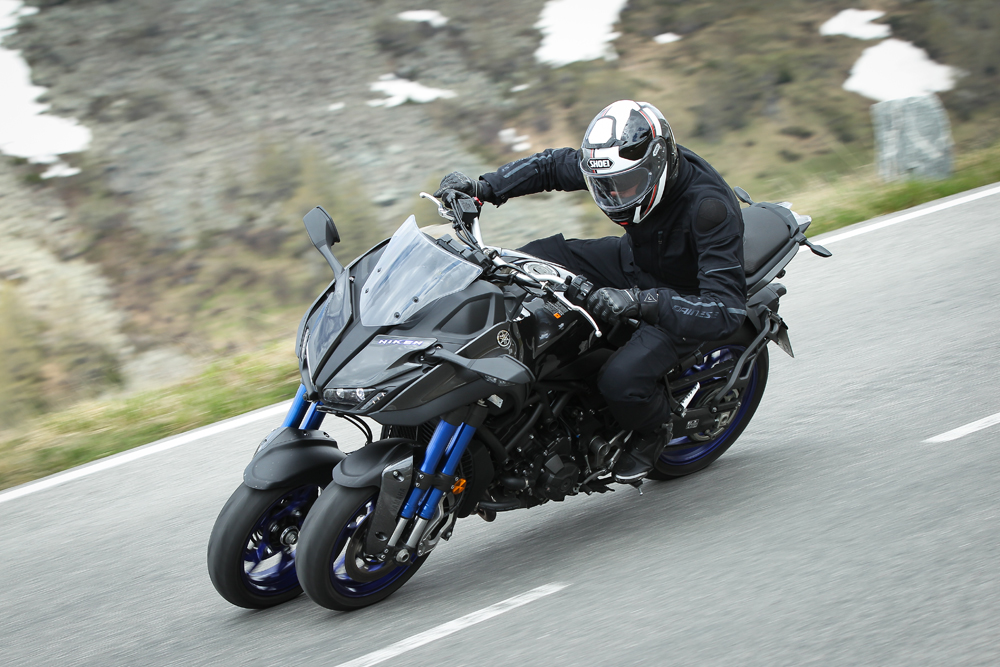 Unlike anything Yamaha has ever created for the public, the Niken represents a shift in thinking for the company.
Unlike anything Yamaha has ever created for the public, the Niken represents a shift in thinking for the company.
Yamaha’s breaking new ground in the powersport turf, debuting an all-new Leaning Multi-Wheel (LMW) vehicle with its 2019 Niken.
Designed with hard core cornering in mind, the Niken, aims to elevate cornering performance to a loftier level than a conventional road-going street bike. To do this, Yamaha leveraged its massive R&D and manufacturing might to establish a fresh and sporty, leaning three-wheel category. Sure, there are other three-wheeled motorcycles and scooters available; however, they don’t handle like this one!
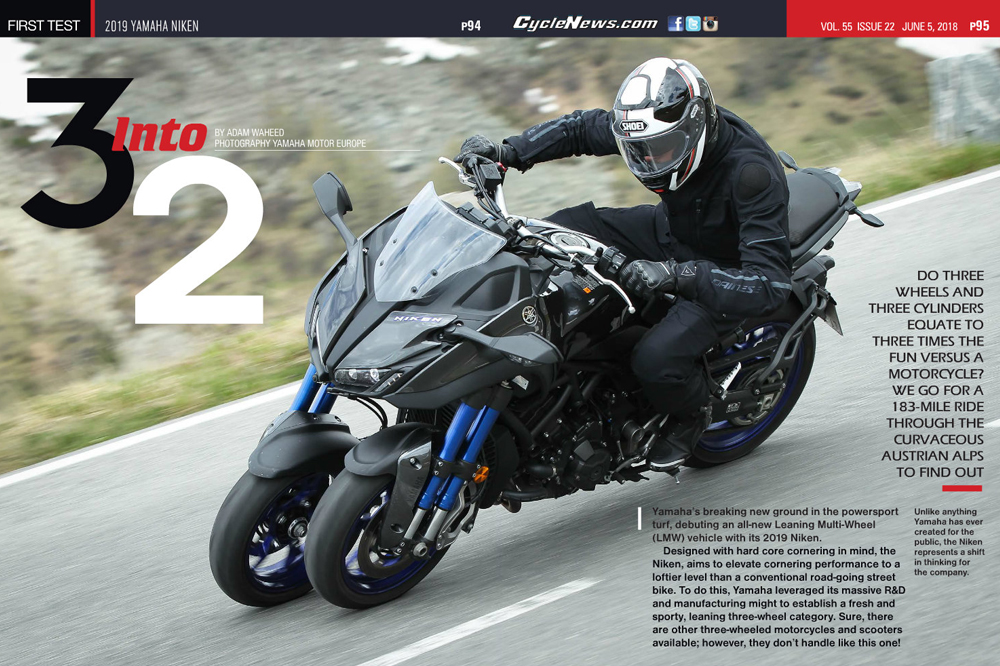
By Adam Waheed | Photography Yamaha Motor Europe
Three-Wheel Motion
Swing a leg over the Niken and it’s clear that this motorcycle is no toy, nor a machine fit for beginners. With a curb weight of 580-pounds and a 59.4-inch wheelbase (0.39 in. longer than the Tracer 900), the Niken naturally requires a reasonable degree of balance and bike-handling skills—especially at low speeds. Although employing three wheels, the Niken doesn’t self-balance, requiring the rider to keep it upright and under control.
Yet, on the road, you’ll be surprised by how maneuverable it is, despite weighing 155 pounds more than its MT-09 sibling—the machine it loosely shares some of its components with. Steering feels natural, and it changes direction with minimal handlebar pressure. Look where you want to go, and this three-wheeler gets there fluidly, just like riding a modern sport motorcycle.
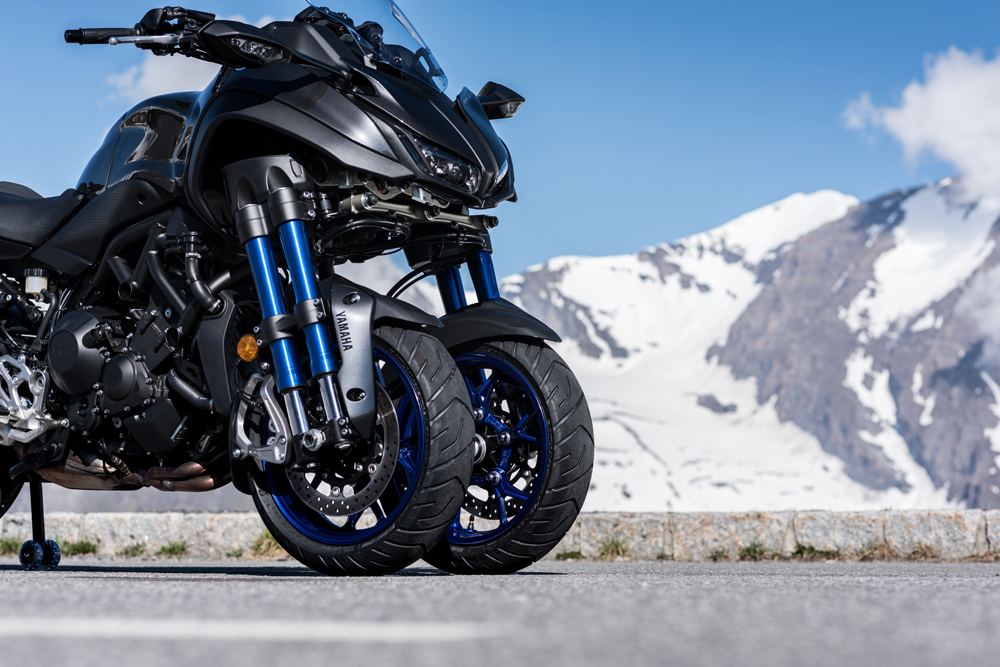 Tell us this thing doesn’t look like it’s come straight off a Star Wars set.
Tell us this thing doesn’t look like it’s come straight off a Star Wars set.
Like a traditional bike, the suspension offers a pleasing degree of movement—compressing during corner entry, pressing down on the specially made 15-inch Bridgestone Battlax A41 tires as you carve through turns. The sensation feels similar to a two-wheeled motorcycle, digging into the pavement through a turn, or a pair of snow skis, for you non-riders.
In fact, Yamaha was so eager to demonstrate the similarities between the two sports, they shoved us down a 9000-foot glacier with our feet strapped in the latest and greatest ski setup from Salomon on our day off.
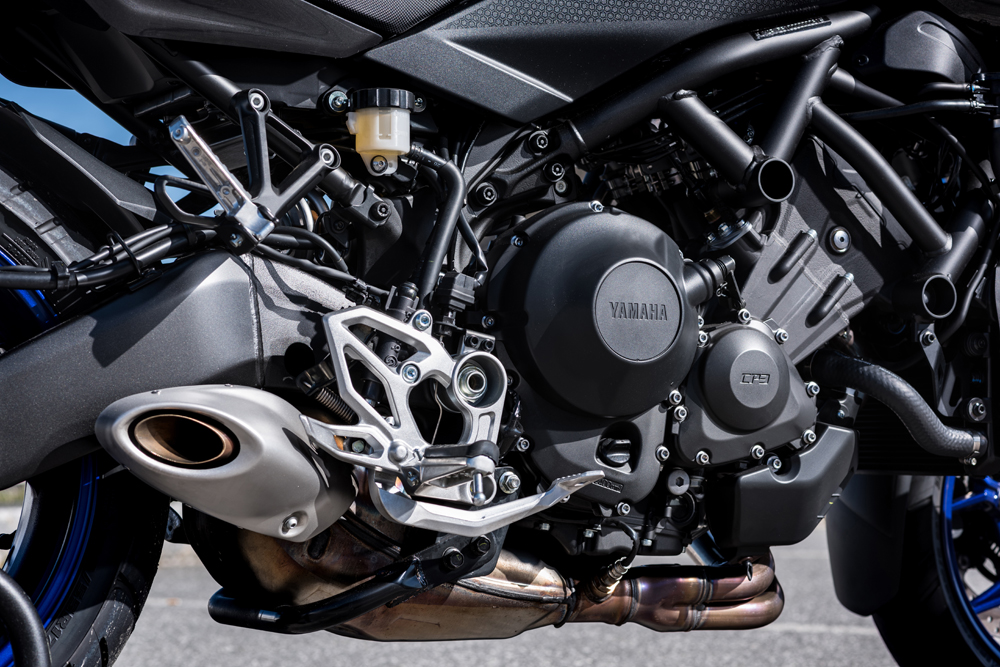 The MT-09-derived triple has been beefed up to cope with the extra weight of the Niken chassis.
The MT-09-derived triple has been beefed up to cope with the extra weight of the Niken chassis.
Trail braking into turns isn’t as critical as its two-wheel brother, since the weight and balance of the machine naturally collapse the front suspension. In fact, the Niken almost performs better if you don’t trail brake. The triple disc brakes have adequate power to get you stopped, and always-on ABS ensures that there will be no drama during a panic stop. Our only gripe is the front brake master cylinder is a tad wimpy feeling. A radial-mount component would no doubt make for added brake feeling and overall performance.
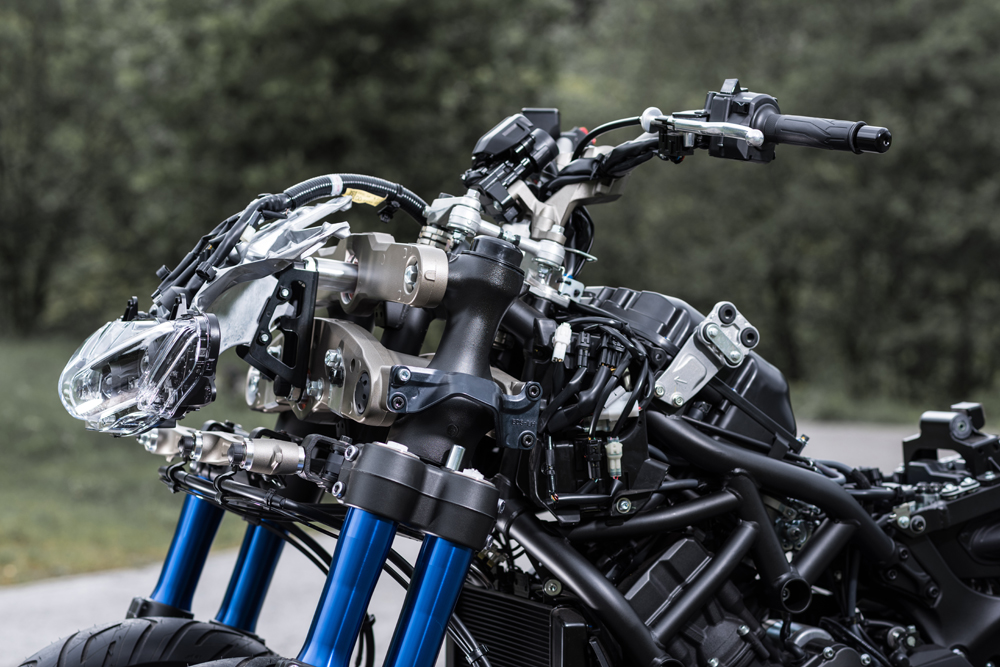 Yamaha has employed a parallelogram linkage system to help control the front end’s four fork legs.
Yamaha has employed a parallelogram linkage system to help control the front end’s four fork legs.
Road feel at lean is a tad muted, so it takes some seat time to gain confidence in the machine’s capabilities when cranked over. But, the more you lean, the better it gets. Let the footpeg feelers be the gauge. Lean until they grind. It took us a better part of the day to trust the chassis enough, and fully commit to deep lean angles. Afterward, it was like a light bulb illuminated in our two-wheeled brain. We get it.
Not only does the suspension offer pleasing road holding through turns, it filters out the wrinkled effects of beat-up pavement. Even after a full day in the saddle, we were raring to ride more. Much of the credit goes to the independent front suspension that somehow offers the best of both worlds, much like a Yamaha FJR sport-touring rig.
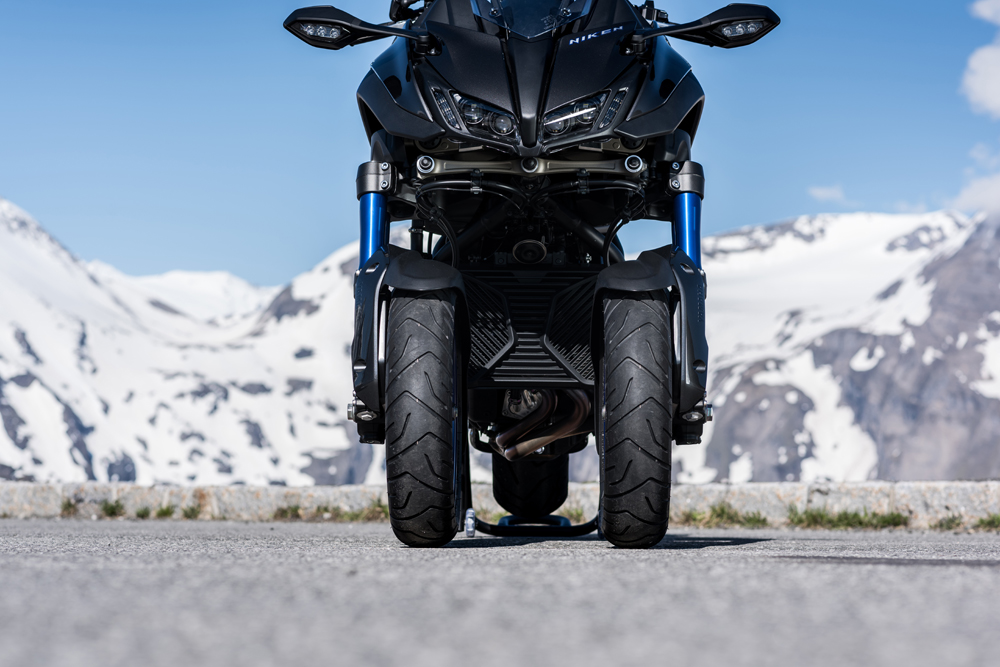 I am Niken, destroyer of worlds.
I am Niken, destroyer of worlds.
Suspension-damping adjustment is offered at each of the rear fork legs as well as the shock absorber. With the OE setting, the rebound of the bike was a tad bouncy, but nothing that a bit of adjustment couldn’t fix.
Well-positioned ergonomics, which are neither too relaxed, nor too sporty, keep you in a comfortable upright riding position. Our only gripe is that the midsection is bulky and the windscreen could be larger to better deflect air over the rider. However, the handlebar bend and coziness of the saddle is spot on.
 A quickshifter in is standard fitment, but only works on the upshift.
A quickshifter in is standard fitment, but only works on the upshift.
As always, Yamaha’s 847cc CP3 three-cylinder engine configuration proves to be a gem, even when fitted inside a heavier chassis. Full of immediate torque, this triple delivers good acceleration grunt in the lower gears—impressive considering some of the oxygen-deprived mountain passes we rode across during our 183-mile day ride through the Austrian Alps. Still, we couldn’t help but wonder how much better it could be with the extra ponies of the YZF-R1’s CP4 engine.
Smooth and rich in character, this engine proves to be fun, playful and eager to run. The six-speed gearbox benefits from an electronic quickshifter, which makes for immediate clutch-less upshifts. Downshifts on the other hand still must be made the old-fashioned way.
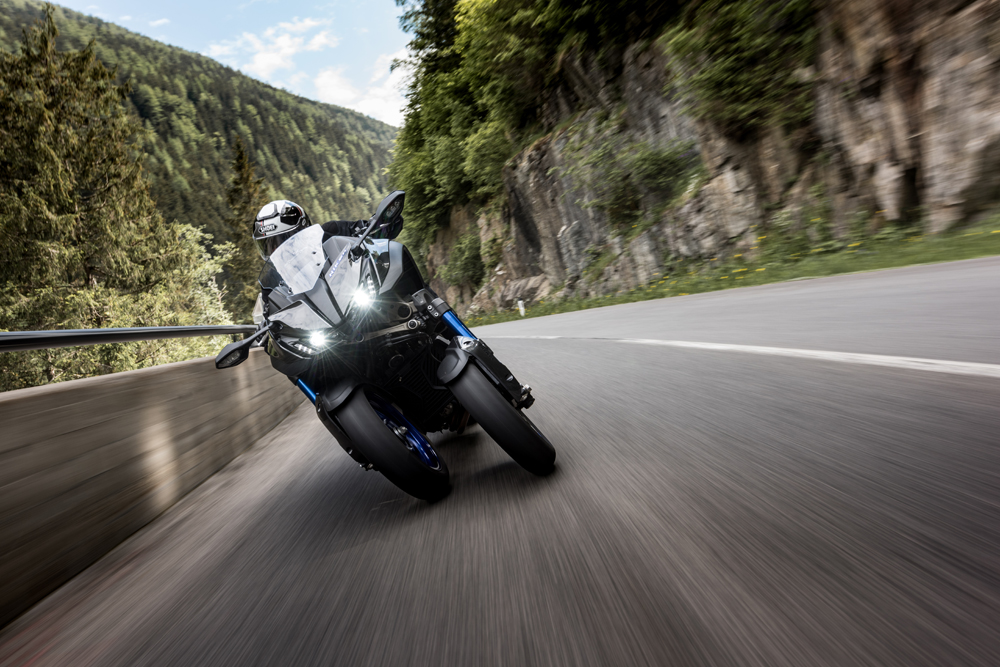 The Niken will obliterate crappy terrain, making long rides a joy.
The Niken will obliterate crappy terrain, making long rides a joy.
Yamaha’s three-way adjustable D-Mode selection allows you to tune the combined effect of the powerband and throttle response. Of the three modes (1, 2 and 3), we preferred the smoother more calibrated response of Mode 2. Riders looking for a big acceleration feel—at the cost of overall smoothness—may prefer Mode 1’s more aggressive setting.
On the other hand, those that want the smoothest feel, for perhaps riding in inclement weather, will likely appreciate Mode 3. Two-way adjustable traction control is also standard, and can be manually disabled at a stop, if, say, you want to pull a wheelie. And yes, with a bit of clutch finesse, the Niken wheelies in first gear. However, the front end comes up quick so make sure to cover that rear brake!
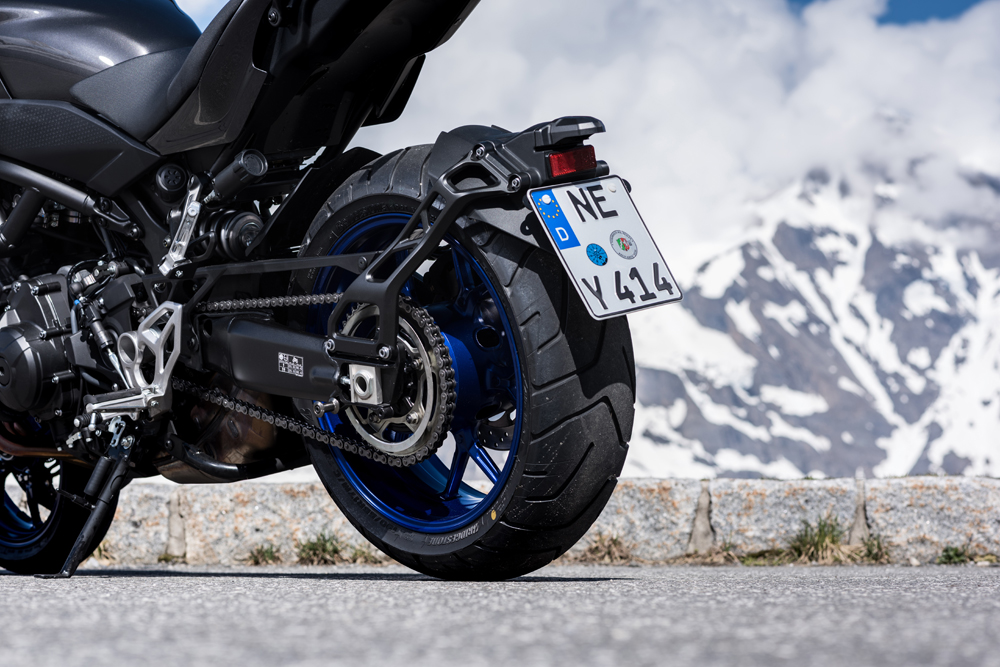 From this end, the Niken looks almost normal.
From this end, the Niken looks almost normal.
So, is the Niken going to replace that shiny new MT-09 in your garage? We don’t think so. It does open up a new world of riding opportunity, allowing riders to enjoy precision cornering in a more sedate, and maybe even safer manner. After all, you don’t have to be an ace rider to exploit the Niken’s greater cornering grip, and that, for some, is going to be the winning ticket. CN
VIDEO | 2018 Yamaha Niken
Inside Niken
One could assume that Yamaha envisioned a three-wheel motorcycle right from the get-go. But as Leon Oosterhof, product planning manger for Yamaha Motor Europe points out, the addition of another front wheel came as an engineering solution, to a simple problem:
“The target was to create a motorcycle with more grip, so it can corner better,” says Oosterhof. “A leaning three-wheeler came out as the solution.”
That, in a nutshell, is how Niken was born. (In case you’re wondering, in Japanese, “ni” stands for “two,” and “ken” refers to “sword.”) But just adding another front wheel, with its own independent suspension, is easier said than done. Yamaha engineers went to work over a greater part of a decade, finally settling on the Niken’s unique front end.
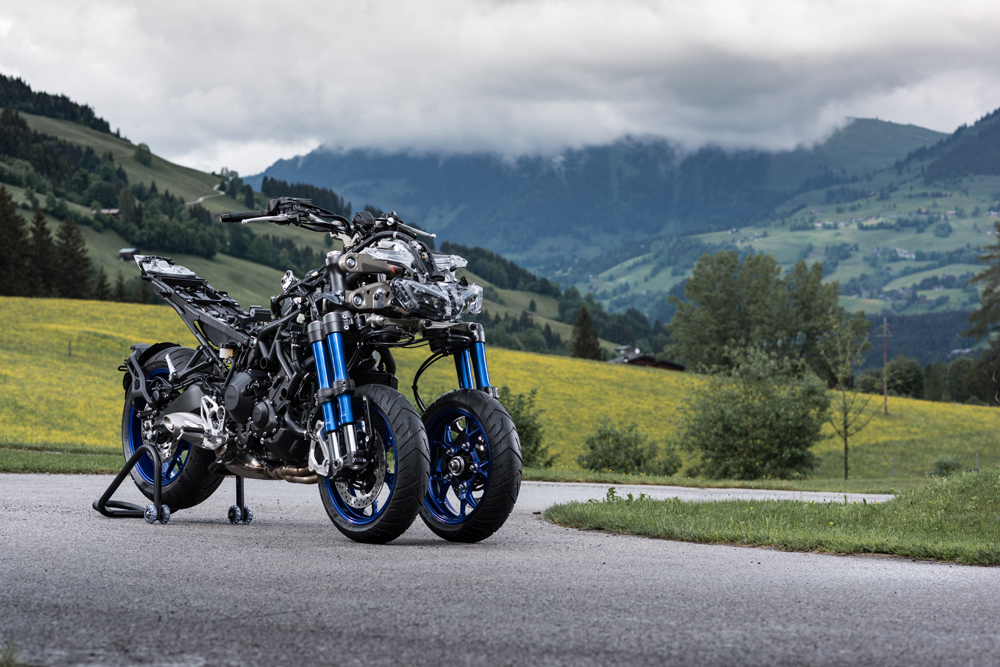 The Niken stripped bare. If you played with model bikes as a kid, this bike will be your jam.
The Niken stripped bare. If you played with model bikes as a kid, this bike will be your jam.
“To create something which really has a huge advantage—and one you can immediately feel, that is the hardest part. We’ve been through many, many, prototypes—most of them, no one has even seen,” he reveals.
The system is underpinned via a “parallelogram” linkage, that’s positioned out of sight, above the two 15-inch alloy front wheels. It controls the lean of the front suspension and ensures that both fork legs remain in alignment. It does this by pivoting on a horizontal axis, offering up to 45 degrees of bank angle on either side.
The linkage controls a pair of inverted fork legs at either side. The dual front fork legs (41mm) keep the wheels (and brakes) in alignment at a constant track of 16.14 inches. Inside, there’s oil for lubrication, with spring and damping handled by the larger diameter (43mm) rear fork. Both compression and rebound damping adjustment is standard, and each pair of fork tubes operate independently of one another with 4.33 inches total travel. This means that each side can respond accurately to road conditions, providing smooth, stable handling.
Because there’re two steering wheels, the inner wheel must follow a tighter radius than the other to ensure no slip or tire scrubbing. To do this, an offset steering knuckle is positioned in front of the linkage, isolating steering input and suspension lean-angle movement.
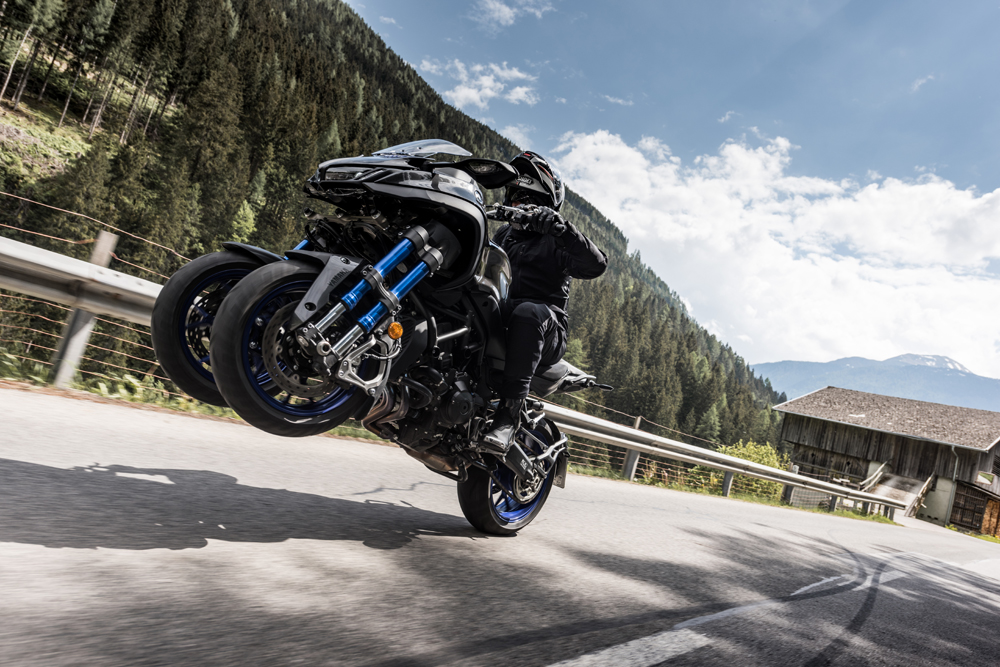
Obviously, achieving a natural, motorcycle-style-steering-feel is a big deal. To do this, the handlebar offset is more rearward to counteract the more forward weight bias. The seating position has shifted rearward by two inches.
Because of its unique dynamic, the Niken’s frame is of an all-new design that was engineered to function with the exceptionally rigid front suspension.
“We really needed to have a dedicated frame to be aligned with the front end. It’s made with a mix of materials (both steel and aluminum) to reach an optimized flex—which is very important,” Oosterhof says. “Because the front is extremely rigid, especially the linkage, to get a good balance in the chassis overall, the main frame beams had to have a certain flex.”
The frame is comprised from a three-piece tubular steel main section with a reinforced steel headstock and cast aluminum swingarm mount. On paper, it appears like the hybrid setup used by Aprilia with its Dorsoduro, only beefier.
Since it is heavier, Yamaha beefed up the CP3 engine to deliver more torque and acceleration feeling. The crankshaft’s inertia force has been increased by 18 percent via thicker webs. The transmission cogs were also strengthened to withstand the additional driveline forces. Lastly, final drive gearing was adjusted with the Niken using a two-tooth larger rear sprocket compared to the MT-09’s 45-tooth setup.
Adaption of the electronics was less demanding, as Oosterhof tells, “we have a different ECU, with different ignition timing, etc. The D-Mode, cruise control, quickshifter and TCS are known Yamaha equipment.”
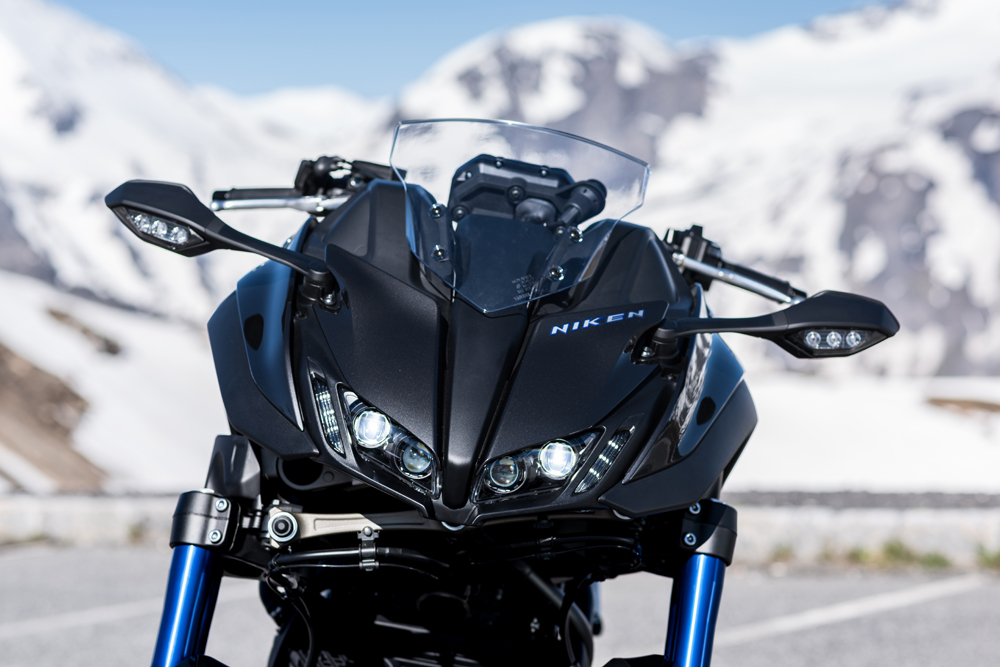 Yamaha’s aiming this at more experienced riders, despite the connotations a three-wheeler has.
Yamaha’s aiming this at more experienced riders, despite the connotations a three-wheeler has.
Who’s it For?
Despite what you may think, Yamaha’s going after a more experienced customer with its Niken. Positioned as a premium offering, it’s engineered to offer a happy medium between traditional sport and touring segments. The Niken rider is a person looking for the latest and greatest technology with a “show-off mindset” says Yamaha’s market research. U.S. pricing and availability has yet to be finalized, but expect an MSRP right around $16,000 with bikes arriving at dealerships later this fall.
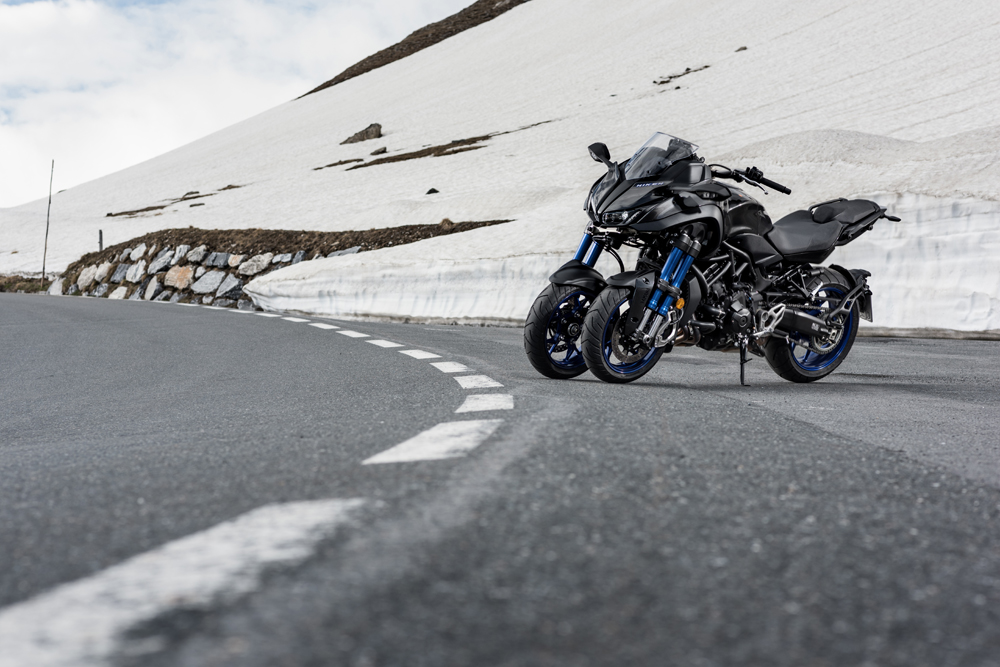 This is the first production three-wheeler from Yamaha, but it’s not their first.
This is the first production three-wheeler from Yamaha, but it’s not their first.
Yamaha’s Multi-Wheel History
Although the Niken is a brand-new offering in Yamaha’s production sport model lineup, the Japanese company has been testing three-wheeled vehicles for over a decade.
Most of these prototypes we’ve never seen—never making it past the initial testing phase. The ones that have, however, include the 01GEN Concept, debuted at the Intermot motorcycle show in 2014 and Tesseract Concept, from the 2007 Tokyo Motor Show.
“We’ve tried different sized wheels: 14s, 15s, 16s, 17s, narrow track less than 400[mm], more than 450, fork legs on the inside, fork legs on the outside, thicker, thinner [fork diameter],” reveals YME’s product planning manager, Aaron Bast. “By trial and error evaluation, modification and testing again, Yamaha’s tried to get the benchmark.
“When you start something new, you don’t know the benchmark, because it doesn’t exist. That was the most challenging part of this project and something that has taken years,” he concludes.CN
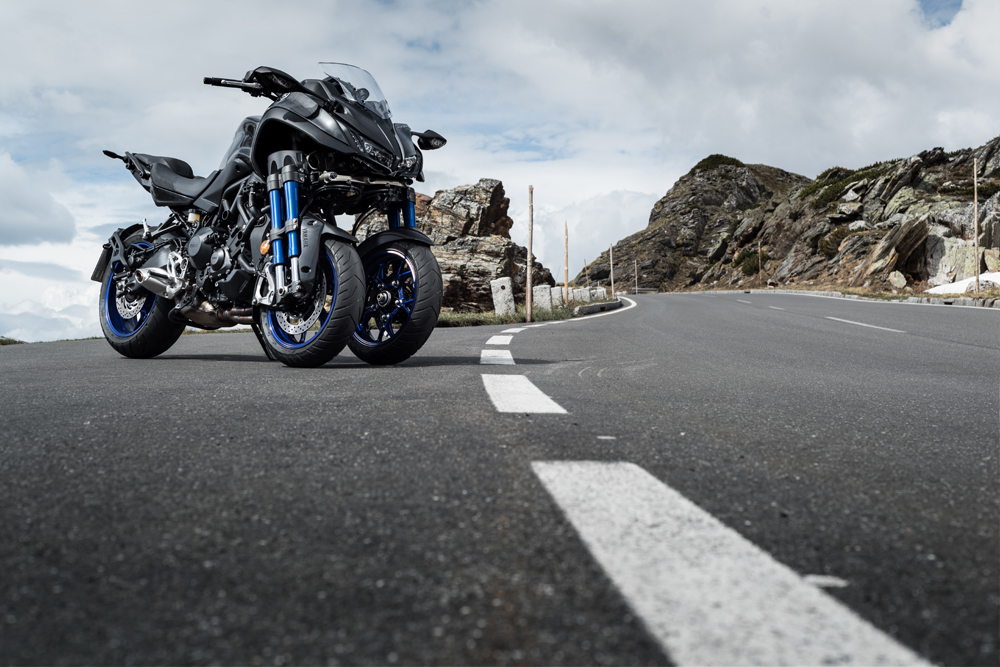
| Specifications |
2018 Yamaha Niken (MSRP TBA) |
| Engine: |
Three-cylinder, 4-stroke, liquid-cooled, DOHC, 12-valves |
| Displacement: |
847cc |
| Bore x stroke: |
78 x 59.1mm |
| Compression ratio: |
11.5:1 |
| Clutch: |
Wet multi-plate, assist and slipper type |
| Transmission: |
6-speed |
| Chassis: |
Steel and aluminum diamond |
| Front suspension: |
41mm upside down telescopic forks, 2 per side, fully adjustable |
| Rear suspension: |
Monoshock, fully adjustable |
| Front brake: |
Dual 265.6mm discs, dual 4-piston caliper, ABS |
| Rear brake: |
Single 298mm disc, 2-piston caliper, ABS |
| Front tire: |
120/70 R 15 |
| Rear tire: |
190/55 R 17 |
| Wheelbase: |
59.4 in. |
| Seat height: |
32.3 in. |
| Fuel capacity: |
4.8 gal. |
| Weight: |
579.8 lbs. (ABS curb, claimed) |
| Color: |
Graphite |